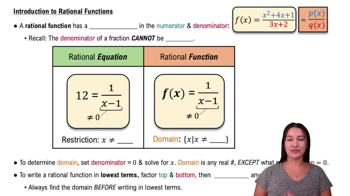Table of contents
- 0. Functions7h 52m
- Introduction to Functions16m
- Piecewise Functions10m
- Properties of Functions9m
- Common Functions1h 8m
- Transformations5m
- Combining Functions27m
- Exponent rules32m
- Exponential Functions28m
- Logarithmic Functions24m
- Properties of Logarithms34m
- Exponential & Logarithmic Equations35m
- Introduction to Trigonometric Functions38m
- Graphs of Trigonometric Functions44m
- Trigonometric Identities47m
- Inverse Trigonometric Functions48m
- 1. Limits and Continuity2h 2m
- 2. Intro to Derivatives1h 33m
- 3. Techniques of Differentiation3h 18m
- 4. Applications of Derivatives2h 38m
- 5. Graphical Applications of Derivatives6h 2m
- 6. Derivatives of Inverse, Exponential, & Logarithmic Functions2h 37m
- 7. Antiderivatives & Indefinite Integrals1h 26m
- 8. Definite Integrals4h 44m
- 9. Graphical Applications of Integrals2h 27m
- 10. Physics Applications of Integrals 2h 22m
1. Limits and Continuity
Finding Limits Algebraically
Problem 2.38
Textbook Question
Limits and Infinity
Find the limits in Exercises 37–46.
2x² + 3
lim -------------
x→⁻∞ 5x² + 7
 Verified step by step guidance
Verified step by step guidance1
Identify the highest degree terms in the numerator and the denominator. In this case, both the numerator and the denominator have the highest degree term of x².
Rewrite the limit expression by factoring out the highest degree term from both the numerator and the denominator. This gives us: lim (x→⁻∞) [(2x²/x²) + (3/x²)] / [(5x²/x²) + (7/x²)].
Simplify the expression by canceling out the x² terms in the numerator and the denominator. This results in: lim (x→⁻∞) [2 + (3/x²)] / [5 + (7/x²)].
Evaluate the limit as x approaches negative infinity. As x becomes very large in magnitude, the terms (3/x²) and (7/x²) approach zero.
Conclude that the limit is the ratio of the leading coefficients of the highest degree terms, which is 2/5.
 Verified video answer for a similar problem:
Verified video answer for a similar problem:This video solution was recommended by our tutors as helpful for the problem above
Video duration:
2mPlay a video:
Was this helpful?
Key Concepts
Here are the essential concepts you must grasp in order to answer the question correctly.
Limits
Limits are fundamental in calculus, representing the value that a function approaches as the input approaches a certain point. They help in understanding the behavior of functions at specific points, including points of discontinuity or infinity. In this context, we are interested in the limit of a rational function as x approaches negative infinity.
Recommended video:

One-Sided Limits
Rational Functions
Rational functions are expressions formed by the ratio of two polynomials. They can exhibit different behaviors as the variable approaches certain values, including infinity. Analyzing the leading terms of the numerator and denominator is crucial for determining the limit of a rational function at infinity.
Recommended video:

Intro to Rational Functions
Behavior at Infinity
The behavior of functions as they approach infinity is essential for evaluating limits. For rational functions, this often involves comparing the degrees of the polynomials in the numerator and denominator. If the degrees are the same, the limit is the ratio of the leading coefficients; if the degree of the numerator is less, the limit approaches zero.
Recommended video:

Cases Where Limits Do Not Exist

 5:21m
5:21mWatch next
Master Finding Limits by Direct Substitution with a bite sized video explanation from Callie
Start learningRelated Videos
Related Practice







